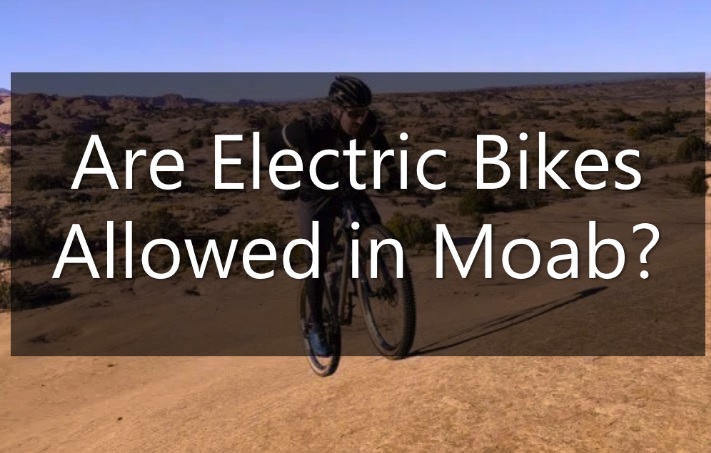Are Electric Bikes Allowed in Moab?

Moab, Utah, is a renowned destination for outdoor enthusiasts, particularly mountain bikers. The area offers breathtaking landscapes and an extensive network of trails that cater to a variety of skill levels. With the rising popularity of electric bikes, many riders wonder whether these vehicles are allowed on the trails in Moab. In this article, we will explore the regulations surrounding electric bikes in Moab. And, we will discuss that are electric bikes allowed in Moab.
Understanding the Regulations in Moab:
To address the growing popularity of electric bikes and their impact on trail systems, land management agencies and local authorities have implemented regulations to ensure a harmonious coexistence between e-bikes and traditional bicycles. The regulations may vary depending on the jurisdiction and the specific trail system.
Moab, located in Grand County, Utah, falls under the jurisdiction of several land management agencies, including the Bureau of Land Management (BLM) and the National Park Service (NPS). These agencies have specific guidelines regarding e-bike usage in the area.
Bureau of Land Management (BLM):
The BLM oversees a significant portion of the public land surrounding Moab. In August 2019, the BLM issued a policy that allows e-bikes on BLM-managed lands. According to this policy, e-bikes are treated similarly to traditional bicycles. E-Bike Classes like Class 1 and Class 2 e-bikes are permitted on roads and trails that are open to bicycles. Class 3 e-bikes are restricted to motorized vehicle routes.
It’s important to note that even though e-bikes are allowed on BLM-managed lands, individual trail managers have the authority to implement additional restrictions. Therefore, it’s essential to check specific trail regulations before riding an e-bike.
National Park Service (NPS):
Arches National Park and Canyonlands National Park, both located near Moab, are managed by the NPS. As of the time of writing, the NPS regulations do not permit e-bikes on non-motorized trails within national parks. However, e-bikes are allowed on paved and unpaved roads open to motor vehicles.
It is crucial to respect the regulations of national parks and adhere to the designated e-bike usage guidelines to avoid potential fines or other penalties.
Local Regulations:
In addition to the regulations set forth by federal land management agencies, local jurisdictions may also have their own rules concerning e-bike usage. It is essential to familiarize oneself with these regulations to ensure compliance. Local bike shops or visitor centers can be valuable resources for obtaining accurate and up-to-date information regarding e-bike regulations in Moab.
Benefits of Electric Bikes in Moab:
The growing popularity of electric bikes in Moab and other outdoor destinations can be attributed to the numerous benefits they offer. Some of these benefits include:
Accessibility:
Electric bikes make cycling more accessible to a wider range of individuals, including those who may have physical limitations or are not accustomed to regular exercise. The motor assistance allows riders to tackle challenging terrain and longer distances with ease.
Extended Range:
With the assistance of an electric motor, e-bikes allow riders to explore greater distances and reach more remote areas within the Moab trail network. This expanded range opens up new opportunities for adventure and exploration.
Reduced Impact:
Electric bikes can contribute to reducing the environmental impact of transportation in the Moab area. By encouraging people to choose e-bikes instead of motorized vehicles, emissions are minimized, and the strain on local infrastructure is reduced.
Environmental Considerations:
The increasing popularity of electric bikes in Moab raises questions about their environmental impact. While e-bikes offer a more eco-friendly alternative to motorized vehicles, they still have some environmental considerations to keep in mind. The use of electric bikes can lead to increased trail erosion if riders venture off designated paths or fail to follow trail etiquette. It is crucial for e-bike riders to stay on designated trails and follow Leave No Trace principles to minimize their impact on the fragile desert ecosystem in Moab. Additionally, responsible battery disposal and maintenance are essential to prevent pollution and ensure the long-term sustainability of electric bike use in the area.
Community Engagement:
Future Outlook: The regulations surrounding electric bikes in Moab are part of an ongoing conversation as technology advances and trail systems evolve. It is possible that future updates to regulations may occur as land management agencies and local authorities reassess e-bike policies based on feedback, research, and the evolving needs of the community. Continued collaboration between e-bike riders, traditional cyclists, hikers, land management agencies, and local authorities is crucial to shaping the future of e-bike access in Moab. By actively participating in the conversation, riders can contribute to the development of sustainable and inclusive policies that ensure the long-term enjoyment of Moab’s trails for all users.
The introduction of electric bikes to Moab’s trails has sparked discussions and debates within the local community. Different stakeholders hold varying opinions on the inclusion of e-bikes in the trail system. It is essential for e-bike riders to engage in respectful and open dialogues with other trail users, such as hikers and traditional cyclists. By fostering understanding and empathy, riders can help bridge the gap between different user groups and work towards creating a more inclusive and harmonious trail experience for everyone. Additionally, participating in trail maintenance and advocacy efforts can further strengthen the bond between e-bike riders and the local community.
Conclusion:
In conclusion, the regulations surrounding electric bikes in Moab are dependent on the land management agency overseeing the specific trail system. The Bureau of Land Management generally permits Class 1 and Class 2 e-bikes on roads and trails open to bicycles, while Class 3 e-bikes are restricted to motorized vehicle routes. The National Park Service, on the other hand, does not allow e-bikes on non-motorized trails within national parks but permits them on roads open to motor vehicles.
As regulations can change over time, it is essential for riders to stay informed and adhere to the current guidelines set forth by the relevant authorities. Respecting the regulations ensures a harmonious experience for all trail users and helps preserve the natural beauty of Moab for future generations. So, if you plan on riding an electric bike in Moab, make sure to do your research, check the local regulations, and enjoy your outdoor adventure responsibly.
